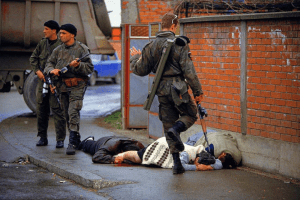Many people have commented on the above image: everyone from Susan Sontag to BBC News and New York Times reporters to Joshua Lipton of the Columbia Journalism Review. The role of the photojournalist is always a point of contention hotly debated by novelists, journalists and scholars alike. After a lot of research, I was unable to find non-American/European sources of commentary.
Susan Sontag was troubled by the aesthetics and almost glorified implications the medium of photography can have on pain. While I would argue that this photo of the Serbian paramilitary member kicking the body of the dying civilian is by no means beautiful it is aesthetically stunning. The color is rich, from the blue car in the back to the brick wall, and the soldier’s action is captured in “the decisive moment” we have discussed this semester. However I do not think that the aesthetics of this photo detracts from the horror this photo captured. One article that I found interesting — which integrated both Sontag’s On The Pain of Others and this specific photo — was “The Other Eye of the Beholder” by Alexander Nehamas in 2003 for The American Prospect. Nehamas argued “Photography is not the only visual medium to go hand in hand with death. Death has been the constant companion of all visual representation since its very beginnings. […] A photograph is “a record of the real.” A photograph demands the pain to be felt. Whether people act on that pain, however, is up to the viewer
Many of the reporters commented on the evidence angle of the Haviv photo perhaps because they too are journalists and understand the plight of documenting rather than interviewing. The LA Times reporter, David Reff, said in a 2001 article “It is almost unimaginable that there could be more than one appropriate interpretation of a Ron Haviv picture.” From BBC to the LA Times it was agreed that this photo perfectly depicted the face of ethnic cleansing and the atrocities going on in Bosnia during this time.
It is evident this photo has been shown in a vast array of news publications, journalistic reviews and was used as evidence in a court of law (which according to The New York Times is rare for photographers to agree to). I feel that the meaning of this image today is still that of a symbol representing ethnic cleansing.
If I were studying the legacy of this image I would speak to the United Nations about it. Haviv was quoted in articles by The New York Times, The Globe and Mail and BBC News that his photos are evidence, evidence for the world governments and the world citizens. “Nobody should be able to say they didn’t know what was happening. What we do as photographers is to attempt to create a body of evidence to hold people accountable” Haviv told The New York Times. I would pose this question to the UN: how many photos of ethnic cleansing, mass genocides and war crimes will you need until this terror comes to an end?
Photojournalists such as Haviv risk their lives to report world news and for us to do nothing in terms of peace or policy making is a disservice to both the photojournalist and more so, our world.
Sources: (all hyperlinked throughout minus the ProQuest database source)
http://www.theglobeandmail.com/news/national/capturing-a-war-crime/article25016202/
http://news.bbc.co.uk/2/hi/europe/1347218.stm
http://articles.latimes.com/2001/jan/21/books/bk-14875/2
http://lens.blogs.nytimes.com/2013/04/02/photography-in-the-docket-as-evidence/?_r=0
http://prospect.org/article/other-eye-beholder
http://search.proquest.com/pqcentral/docview/230360791/74834B4D519F43D7PQ/1?accountid=12768

Recent Comments